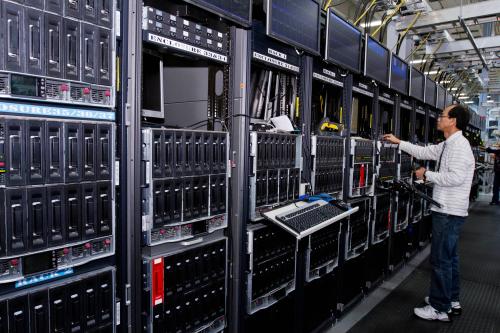American politicians – both Republican and Democratic – hold up homeownership as a cornerstone of middle class life. No surprise, then, that housing policy in the U.S. tilts the playing field in favor of homeownership rather than renting. Federal tax policy gives special preferences to owner-occupied housing, through the mortgage interest deduction and capital gains exclusion. Local land use policies allow single-family homes to be built in more locations, and with fewer barriers, than apartment buildings. Political rhetoric, again from both parties, reinforces the idea that renting a home should be seen as a temporary state, a waystation on the journey to the final destination of homeownership. Homeownership has lots of pros, of course – but some cons, too. Rather than viewing homeownership as an goal in and of itself, policymakers should create more pathways to economic opportunity and financial security for both owners and renters.
Stable, decent housing in a safe, healthy community is a fundamental need. Owning one’s home is not.
Housing is what economists call a “composite” good, i.e. meeting several different goals. Chief among these goals are:
- Shelter. At its core, housing is a basic human need. Physical structures protect us from the elements, provide privacy and security to sleep, eat, and store our belongings.
- Stability. Knowing where you will live this month and the next — and that you will be pay the rent or mortgage – provides a stable foundation for making plans and being able to carry out other social and economic functions.
- Location. Where we live determines our access to jobs and schools, as well as proximity to stores and services.
- Wealth. In some circumstances, housing (in the form of homeownership) may be a way to build wealth.
One important reason to rethink the policy bias towards homeownership is that fewer people will benefit, since demographic trends suggest that the U.S. will have declining homeownership rates over time. The share of households owning their home is lower than nearly 20 years, and the drop is particularly large for younger households – the cohort that entered the labor market during the Great Recession and recovery years:
It is also important to remember that tenure changes are not a one-way flow, with young adults starting life as renters until they can afford to become homeowners, and then staying homeowners for the rest of their lives. Rather, individuals and families undergo periods of renting and owning throughout their lives – and demographic changes will increase these cycles. Young adults are waiting longer to form households, start families, and buy their first homes. As Baby Boomers age, many older adults will need to reduce the maintenance obligations of homeownership. When a couple who own a home separates, one or both will often become renters. The foreclosure crisis caused an historic number of owners to lose their homes, becoming renters involuntarily. Some households – especially those living in high cost metropolitan areas – will spend more of their lifetimes as renters than as owners.
Homeownership can provide stability and wealth-building opportunities…
Homeownership offers some financial advantages over renting. Making regular payments on an amortizing mortgage is a “forced savings” mechanism, meaning that homeowners are paying down debt and accumulating equity with each payment. (During the first few years of mortgages, most of the monthly payment applies to interest owed rather than principal.) By contrast, rent payments only cover the consumption value of housing and do not accumulate savings. Owning one’s home also provides greater stability and predictability of housing expenditures than renting. For the typical U.S. homeowner with a 30 year fixed rate mortgage, the greatest portion of monthly housing costs remain fixed over a very long term. Renters only know their monthly housing costs for the duration of their current lease, most commonly one year. Predictable housing expenditures translates into greater housing stability for owners relative to renters. Moving to a different home is expensive and disruptive, especially for families with school-age children. Policymakers frequently justify the heavy homeownership bias in U.S. tax policy by arguing that homeownership has spillover benefits for surrounding communities. Research has shown mixed results on claims that homeowners are better parents, and engage more in civic and political affairs, for instance. (It’s also possible that political processes dominated by homeowners have contributed to rising housing costs).
…but also makes for financial risk and costs of maintenance
The Great Recession of 2007-2009 provided a harsh reminder that, like all financial investments, homeownership is risky. Owners may realize large wealth gains over their initial investment, but there are no guarantees against losing wealth – and house price growth varies widely across the U.S. By standard measures of diversification, parking a large share of your wealth in a single piece of real estate is not an optimal investment strategy. Buying a house in the same metropolitan area where one works further increases risk, because local housing values are correlated with the performance of local labor markets. Also, wealth gains from homeownership have been unevenly distributed across U.S. families, by geography and by race. Black and Latino families face higher barriers to homeownership, and suffered greater losses in housing wealth during the Great Recession. At the same time, buying and selling a house comes with substantial financial – and psychological – costs. Real estate transactions involve multiple intermediaries – real estate agents, mortgage brokers, appraisers, and home inspectors – each of whom charges a fee. Home buying is one of the most stressful events most households undergo. While renters can call their property manager or building supervisor to fix a leaky sink or replace broken windows, homeowners must invest their own time and money to maintain their homes.
Three policy approaches to help renters:
Considering both the costs and benefits, homeownership should be viewed not as an end goal of public policy, but rather as one possible mechanism to achieve several different policy goals. Instead of focusing on how to move renters into homeownership, a better question for policymakers would be: how can policies help both renters and owners achieve the financial benefits associated with homeownership, while choosing the tenure that best fits their financial needs, lifestyle preferences, and life cycle stage? Three areas are particularly important for policy change.
- Encourage a diverse housing supply in high-opportunity neighborhoods
Both renters and owners want good neighborhood amenities: access to employment centers and transportation, safe streets, good public schools, grocery stores and other basic household services. Too often, local zoning laws restrict the development of apartments in high opportunity neighborhoods. In particular, many affluent residential areas only allow single-family detached homes, which are the most expensive housing type to purchase or rent. Allowing multifamily buildings by right in all residential areas — as Minneapolis’ new Comprehensive Plan does — would substantially increase renters’ access to high-amenity neighborhoods.
- Provide greater housing cost predictability and stability
One disadvantage of renting is uncertainty about the future – both in terms of whether you will be in same place, and how much it will cost. For low-income families, residential instability is largely a function of not having enough income to cover monthly rent. Providing more income support – whether through expanded housing vouchers or mechanisms like the EITC – would help these families. In markets where housing costs rise faster than incomes, even moderate- and middle-income renters may not be able to absorb rent increases when their leases expire. One way to hedge against rent inflation could be to expand the use of multi-year leases (already the norm in commercial real estate and for residential properties in some non-U.S. countries). Such leases could set out pre-determined annual rent increases or could tie rent changes to some external cost index (similar to the mechanism for adjustable rate mortgages). Another area under discussion is expanding renter protections under landlord-tenant laws. The 2007 foreclosure crisis drew attention to numerous information failures in the mortgage market, leading federal regulators to provide more information disclosure and other consumer protections for new home buyers. However, tenant protections also need to be carefully designed to avoid unintended consequences that harm vulnerable renters. (I’m going to come back to this in a future piece.)
- Incentivize savings and wealth-building through a diversified portfolio of liquid assets
That homeownership has become the default wealth-building mechanism in the U.S. creates challenges for long-term renters, as well as for homeowners in locations with stagnant housing values. Policymakers should develop alternative programs that make use of the best features of homeownership. In particular, designing programs with “nudges” learned from behavioral economics could imitate the “forced savings” mechanism of homeownership. Further, any wealth building program should offer professional asset management (because most individual investors are poor at picking stock market winners) and low transaction fees. (This too is an area that scholars in the Future of the Middle Class Initiative will have more to say on soon.)
A truly progressive political agenda would seek to make renting one’s home – whether for a year or for a lifetime – more financially stable and more socially acceptable for middle-class Americans.
Politicians: mind your language
After many decades of U.S. political leaders holding out homeownership as the gold standard, it will take changes in rhetoric as well as hard policy to help Americans stop viewing renting as the tenure of last resort. Current policies favoring homeownership are not only unfair to renter households, they fall short of the nation’s capacity for wealth building. A truly progressive political agenda would seek to make renting one’s home – whether for a year or for a lifetime – more financially stable and more socially acceptable for middle-class Americans.
The Brookings Institution is committed to quality, independence, and impact.
We are supported by a diverse array of funders. In line with our values and policies, each Brookings publication represents the sole views of its author(s).







Commentary
Renting the American Dream: Why homeownership shouldn’t be a prerequisite for middle-class financial security
February 13, 2019